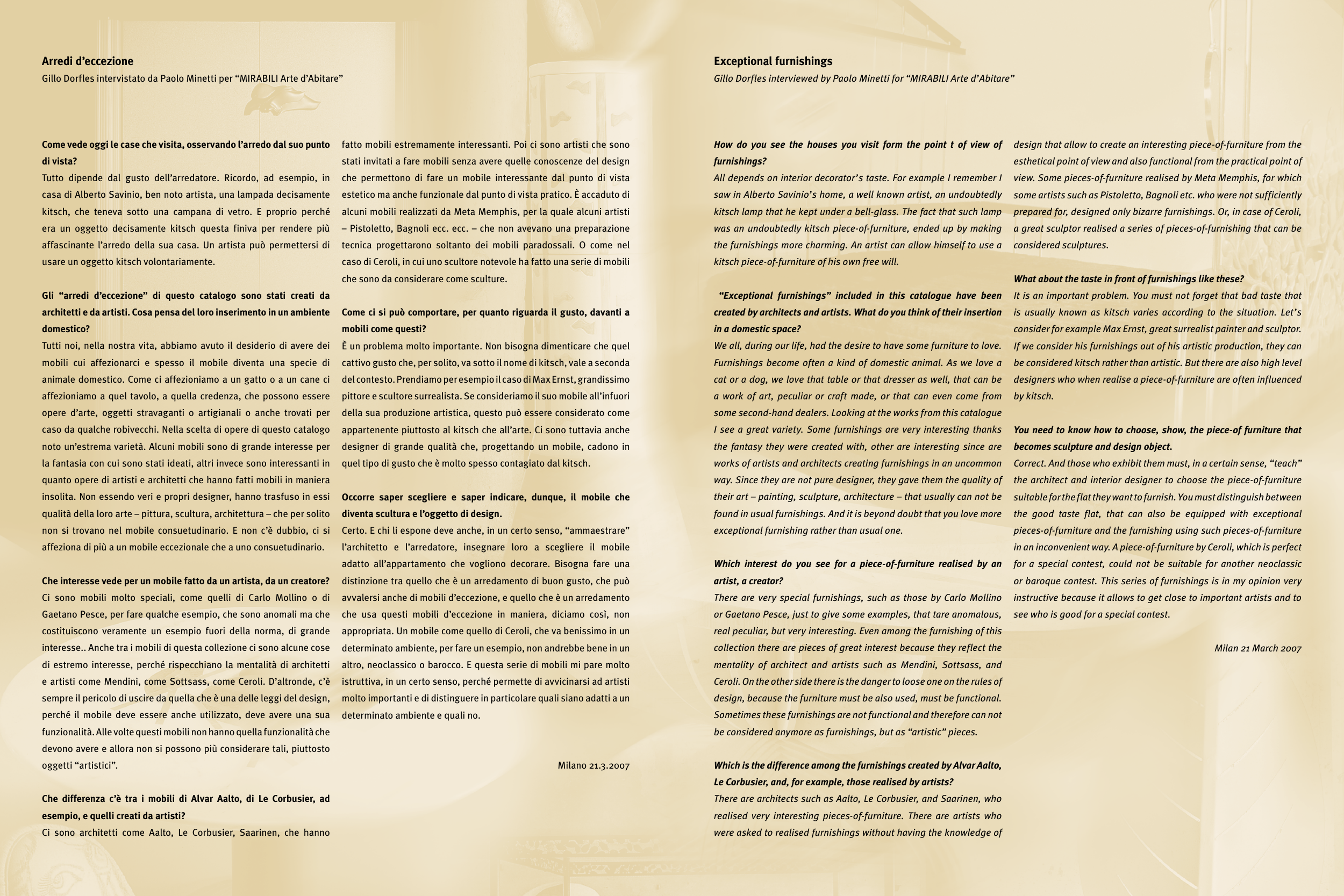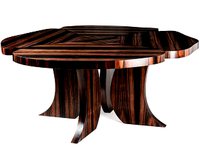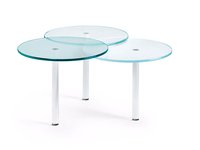Come vede oggi le case che visita, osservando l’arredo dal suo punto
di vista?
Tutto dipende dal gusto dell’arredatore. Ricordo, ad esempio, in
casa di Alberto Savinio, ben noto artista, una lampada decisamente
kitsch, che teneva sotto una campana di vetro. E proprio perché
era un oggetto decisamente kitsch questa finiva per rendere più
affascinante l’arredo della sua casa. Un artista può permettersi di
usare un oggetto kitsch volontariamente.
Gli “arredi d’eccezione” di questo catalogo sono stati creati da
architetti e da artisti. Cosa pensa del loro inserimento in un ambiente
domestico?
Tutti noi, nella nostra vita, abbiamo avuto il desiderio di avere dei
mobili cui affezionarci e spesso il mobile diventa una specie di
animale domestico. Come ci affezioniamo a un gatto o a un cane ci
affezioniamo a quel tavolo, a quella credenza, che possono essere
opere d’arte, oggetti stravaganti o artigianali o anche trovati per
caso da qualche robivecchi. Nella scelta di opere di questo catalogo
noto un’estrema varietà. Alcuni mobili sono di grande interesse per
la fantasia con cui sono stati ideati, altri invece sono interessanti in
quanto opere di artisti e architetti che hanno fatti mobili in maniera
insolita. Non essendo veri e propri designer, hanno trasfuso in essi
qualità della loro arte – pittura, scultura, architettura – che per solito
non si trovano nel mobile consuetudinario. E non c’è dubbio, ci si
affeziona di più a un mobile eccezionale che a uno consuetudinario.
Che interesse vede per un mobile fatto da un artista, da un creatore?
Ci sono mobili molto speciali, come quelli di Carlo Mollino o di
Gaetano Pesce, per fare qualche esempio, che sono anomali ma che
costituiscono veramente un esempio fuori della norma, di grande
interesse.. Anche tra i mobili di questa collezione ci sono alcune cose
di estremo interesse, perché rispecchiano la mentalità di architetti
e artisti come Mendini, come Sottsass, come Ceroli. D’altronde, c’è
sempre il pericolo di uscire da quella che è una delle leggi del design,
perché il mobile deve essere anche utilizzato, deve avere una sua
funzionalità. Alle volte questi mobili non hanno quella funzionalità che
devono avere e allora non si possono più considerare tali, piuttosto
oggetti “artistici”.
Che differenza c’è tra i mobili di Alvar Aalto, di Le Corbusier, ad
esempio, e quelli creati da artisti?
Ci sono architetti come Aalto, Le Corbusier, Saarinen, che hanno
fatto mobili estremamente interessanti. Poi ci sono artisti che sono
stati invitati a fare mobili senza avere quelle conoscenze del design
che permettono di fare un mobile interessante dal punto di vista
estetico ma anche funzionale dal punto di vista pratico. È accaduto di
alcuni mobili realizzati da Meta Memphis, per la quale alcuni artisti
– Pistoletto, Bagnoli ecc. ecc. – che non avevano una preparazione
tecnica progettarono soltanto dei mobili paradossali. O come nel
caso di Ceroli, in cui uno scultore notevole ha fatto una serie di mobili
che sono da considerare come sculture.
Come ci si può comportare, per quanto riguarda il gusto, davanti a
mobili come questi?
È un problema molto importante. Non bisogna dimenticare che quel
cattivo gusto che, per solito, va sotto il nome di kitsch, vale a seconda
del contesto. Prendiamo per esempio il caso di Max Ernst, grandissimo
pittore e scultore surrealista. Se consideriamo il suo mobile all’infuori
della sua produzione artistica, questo può essere considerato come
appartenente piuttosto al kitsch che all’arte. Ci sono tuttavia anche
designer di grande qualità che, progettando un mobile, cadono in
quel tipo di gusto che è molto spesso contagiato dal kitsch.
Occorre saper scegliere e saper indicare, dunque, il mobile che
diventa scultura e l’oggetto di design.
Certo. E chi li espone deve anche, in un certo senso, “ammaestrare”
l’architetto e l’arredatore, insegnare loro a scegliere il mobile
adatto all’appartamento che vogliono decorare. Bisogna fare una
distinzione tra quello che è un arredamento di buon gusto, che può
avvalersi anche di mobili d’eccezione, e quello che è un arredamento
che usa questi mobili d’eccezione in maniera, diciamo così, non
appropriata. Un mobile come quello di Ceroli, che va benissimo in un
determinato ambiente, per fare un esempio, non andrebbe bene in un
altro, neoclassico o barocco. E questa serie di mobili mi pare molto
istruttiva, in un certo senso, perché permette di avvicinarsi ad artisti
molto importanti e di distinguere in particolare quali siano adatti a un
determinato ambiente e quali no.
Milano 21.3.2007
How do you see the houses you visit form the point t of view of
furnishings?
All depends on interior decorator’s taste. For example I remember I
saw in Alberto Savinio’s home, a well known artist, an undoubtedly
kitsch lamp that he kept under a bell-glass. The fact that such lamp
was an undoubtedly kitsch piece-of-furniture, ended up by making
the furnishings more charming. An artist can allow himself to use a
kitsch piece-of-furniture of his own free will.
“Exceptional furnishings” included in this catalogue have been
created by architects and artists. What do you think of their insertion
in a domestic space?
We all, during our life, had the desire to have some furniture to love.
Furnishings become often a kind of domestic animal. As we love a
cat or a dog, we love that table or that dresser as well, that can be
a work of art, peculiar or craft made, or that can even come from
some second-hand dealers. Looking at the works from this catalogue
I see a great variety. Some furnishings are very interesting thanks
the fantasy they were created with, other are interesting since are
works of artists and architects creating furnishings in an uncommon
way. Since they are not pure designer, they gave them the quality of
their art – painting, sculpture, architecture – that usually can not be
found in usual furnishings. And it is beyond doubt that you love more
exceptional furnishing rather than usual one.
Which interest do you see for a piece-of-furniture realised by an
artist, a creator?
There are very special furnishings, such as those by Carlo Mollino
or Gaetano Pesce, just to give some examples, that tare anomalous,
real peculiar, but very interesting. Even among the furnishing of this
collection there are pieces of great interest because they reflect the
mentality of architect and artists such as Mendini, Sottsass, and
Ceroli. On the other side there is the danger to loose one on the rules of
design, because the furniture must be also used, must be functional.
Sometimes these furnishings are not functional and therefore can not
be considered anymore as furnishings, but as “artistic” pieces.
Which is the difference among the furnishings created by Alvar Aalto,
Le Corbusier, and, for example, those realised by artists?
There are architects such as Aalto, Le Corbusier, and Saarinen, who
realised very interesting pieces-of-furniture. There are artists who
were asked to realised furnishings without having the knowledge of
design that allow to create an interesting piece-of-furniture from the
esthetical point of view and also functional from the practical point of
view. Some pieces-of-furniture realised by Meta Memphis, for which
some artists such as Pistoletto, Bagnoli etc. who were not sufficiently
prepared for, designed only bizarre furnishings. Or, in case of Ceroli,
a great sculptor realised a series of pieces-of-furnishing that can be
considered sculptures.
What about the taste in front of furnishings like these?
It is an important problem. You must not forget that bad taste that
is usually known as kitsch varies according to the situation. Let’s
consider for example Max Ernst, great surrealist painter and sculptor.
If we consider his furnishings out of his artistic production, they can
be considered kitsch rather than artistic. But there are also high level
designers who when realise a piece-of-furniture are often influenced
by kitsch.
You need to know how to choose, show, the piece-of furniture that
becomes sculpture and design object.
Correct. And those who exhibit them must, in a certain sense, “teach”
the architect and interior designer to choose the piece-of-furniture
suitable for the flat they want to furnish. You must distinguish between
the good taste flat, that can also be equipped with exceptional
pieces-of-furniture and the furnishing using such pieces-of-furniture
in an inconvenient way. A piece-of-furniture by Ceroli, which is perfect
for a special contest, could not be suitable for another neoclassic
or baroque contest. This series of furnishings is in my opinion very
instructive because it allows to get close to important artists and to
see who is good for a special contest.
Milan 21 March 2007
Arredi d’eccezione
Gillo Dorfles intervistato da Paolo Minetti per “MIRABILI Arte d’Abitare”
Exceptional furnishings
Gillo Dorfles interviewed by Paolo Minetti for “MIRABILI Arte d’Abitare”







